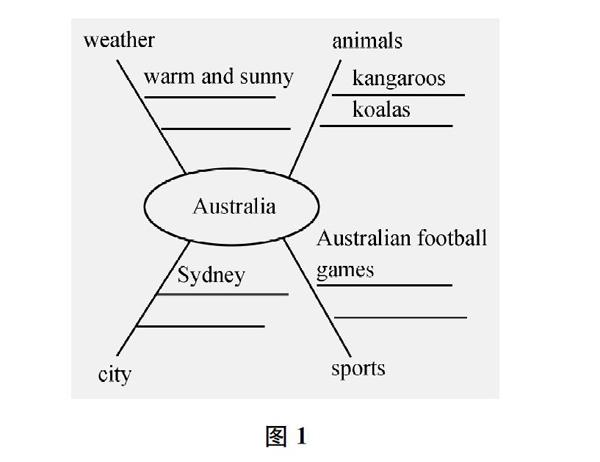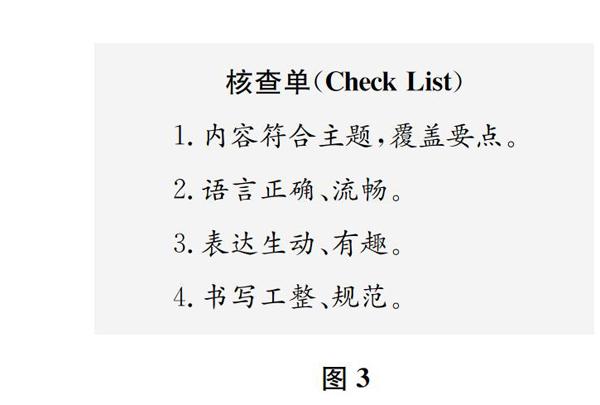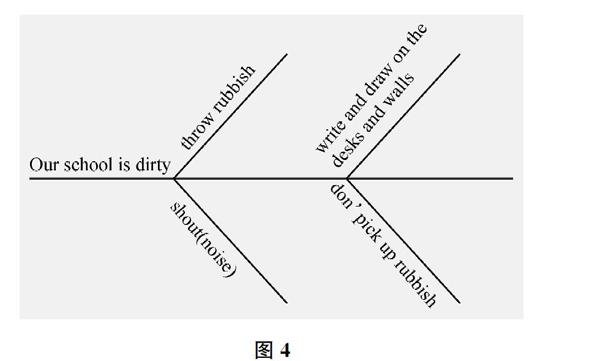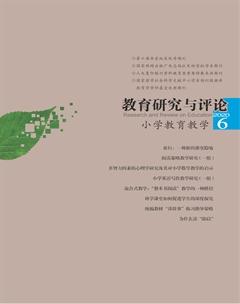图形组织器在小学英语写作教学中的运用
申菁



摘要:图形组织器是用图形呈现文章的脉络,使文章内容更形象化。图形组织器的作用是在某些特定的图示帮助下,让学习者对事物、观点之间的相互关系有更深刻的理解。根据不同的写作主题、写作类别,在教学中分别引入描述类图形组织器、因果类图形组织器、对比类图形组织器。
关键词:图形组织器小学英语写作教学
刘政良和申昌安在《图形组织器:促进学习者高阶思维发展的学习工具》一文中指出,图形组织器是一种可视工具,是依靠图片和图形结构展示的方式表现出整个学习过程以及学习结果的学习工具,也是一种方便学生构建知识框架和处理组织语言信息的教学方式。简单来说,它是用图形的方式呈现文章的脉络,使文章内容更形象化。根据不同的作用,可将图形组织器分为六大类:描述类图形组织器、因果类图形组织器、对比类图形组织器、分类图形组织器、序列类图形组织器以及决策类图形组织器。图形组织器主要用于对知识、概念、观点进行可视化表达,其作用是在某些特定的图示帮助下,让学习者对事物、观点之间的相互关系有更深刻的理解。
小学生天性好动,擅长形象思维,有意注意的时间较短。在写作教学中适时引入图形组织器,能激活学生的视觉智能,拓展学生思维能力,促使他们自主建构文章结构,组织素材,输出语言。本文主要探讨描述类图形组织器、因果类图形组织器、对比类图形组织器在小学英语写作教学中的运用。
一、描述类图形组织器的运用
描述类图形组织器通常聚焦某一特定主题,适于表征事实性或概念性的知识。蛛形图是此类图形组织器的典型代表。蛛形图,顾名思义,其图形结构是一只简化的蜘蛛,蜘蛛的中心部分是被讨论的特定主题,“分肢”是与主题相关联的信息。在英语写作教学中运用这种形式自由的图形组织器,有助于学生在发散的信息与特定主题间搭建联系,使其想法更加形象化,思维更有逻辑性。
译林版小学英语六年级下册Unit 6 An interesting country讲的是孩子们想要了解澳大利亚的相关知识,他们将从多种渠道了解这个国家,主人公刘涛在因特网上了解到了澳大利亚的信息。学完本课,笔者打算让学生试着写一写如何描述一个有趣的国家。首先,笔者给出主题词country(国家),让学生头脑风暴,说一说自己知道的国家名称,引出写作主题。接下来,师生展开讨论:
师You know the names of different countries. In Unit6, we learned something about an interesting country. What is it?
生Australia.
师Yes. What do you know about it now?
(教师画出蛛形图轮廓,在中心部分写上“Australia”。)
生We can see kangaroos and Koalas in Australia.
师You know some animals. Do you like them?
(教师在蛛形图“蜘蛛”的一“肢”上板书“animals”。)
生Certainly.
生Sportlovers will like Australian football games.
師You know some sports. (在蛛形图“蜘蛛”的一“肢”上板书“sports”) Are Australian football games exciting?
生Yes.They are all very exciting.
生Sydney is a beautiful city.
师You know something about the city in Australia. Do you want to visit it?(在蛛形图“蜘蛛”的一“肢”上板书“city”)What else do you know about it?
生I want to visit Sydney very much.
生The weather is warm and sunny in Australia.
师Well, the weather is different from ours. (播放关于澳大利亚的视频)Now Ill show you a video. Youll know whats the weather like in Australia.
(学生观看视频。)
师(在蛛形图“蜘蛛”的最后一“肢”上板书“weather”)So boys and girls, look at the blackboard. I put what you said in it.(让学生认真观察图1)It looks like a ...
图1
生Spider.
师This is a Spider Map. It will help you collect your ideas in writing. Look! Animals, sports, city, weather are four aspects about Australia. They are detailed information closely related with the topic. According to it, I wrote something.(出示图2)Lets read together.
Australia is an interesting country. Its often warm and sunny. Sydney is a beautiful city. Youll see kangaroos and Koalas in Australia. Sportlovers will like Australian football games.
图2(学生读图2中的短文。)
师(出示下页图3)Now,we will write about an interesting country—Australia. Is it a nice passage? Take out your check list and discuss in groups.
核查单(Check List)
1.内容符合主题,覆盖要点。
2.语言正确、流畅。
3.表达生动、有趣。
4.书写工整、规范。
图3(学生根据核查单评价上页图2所示的短文。)
师What do you think of the passage?
生Its not interesting.
师So how can we revise our writing? We can highlight “interesting”of Australia.
生We can add some interesting things in it. Like kangaroos and koalas are cute.
师Good idea.
生We can combine “Sportlovers will like Australian football games” and “theyre very exciting” using “because”.
……
师Thanks for your advice. Ill rewrite it. So in order to make it interesting, we can use one or more sentences to further describe your ideas. Some adjectives can also make your writing beautiful.Well,boys and girls, lets use the Spider Map to write an interesting country you like.First, choose the country and write down the name in the centre of the Spider Map.Second, fill in the Spider Map with your ideas.Third, write according to the Spider Map.Last, check and revise according to the checklist.
(学生思考写作,然后展示自己的蛛形图和习作。)
笔者在教学中发现,小学生进行英语写作时,常常无法有条理地整理自己的思路,无法聚焦中心思想,写出来的东西往往东拼西凑。蛛网图可以有效地帮助他们理清思路,让思想形象化。
上述教学中,教师让学生学着描述一个国家,借助蛛网图,学生明确可以从animal(动物), sport(运动), city(城市), weather(天气)几个方面入手,进行有条理的描写。
需要注意的是,图形组织器是为学生的写作学习服务的,不能为了用而用。将描述类图形组织器运用于写作教学时,教师不必急着向学生展示图示,而要先通过复习课文,与学生一边梳理课文知识,总结零散信息,一边构建图示。当知识梳理清晰时,学生也就领会了构建图形组织器的基本要领。接下来,在学生完成写作的基础上,教师引导学生自主核查所写内容是否符合主题,是否覆盖蛛网图中所列出的要点,语言是否正确流利且表达生动有趣,书写是否工整规范。在此基础上修改文章,不仅写作的信息更丰富,素材也更加贴近主题。
二、因果类图形组织器的运用
因果类图形组织器一般用于分析影响事物的因素和事物所带来的影响。常用的因果类图形组织器是鱼骨圖。鱼骨图,即用鱼刺来呈现一个复杂的想法或事件中的因果关系。运用这个图形组织器,一般是从事件的结果开始——事件的结果,是鱼骨的主干部分;引起结果的各种原因,是鱼骨的分支。这个组织器能帮助学生理解与一个中心主题相关的许多想法。
译林版小学英语六年级上册Unit 6 Keep our city clean意在让学生通过分析城市变脏的原因,找到污染根源,并针对问题找到保护环境的具体措施。这是一篇关于环保的实用性文章。笔者打算以此为话题,引入鱼骨图,展开环保话题写作教学,加强学生的环境保护意识。教学过程如下:
师Boys and girls, nowadays some of the cities are messy and dirty. What makes the city dirty?
生Smoke from cars make the city dirty.
生Rubbish makes the streets messy and dirty.
生Black smoke from factories makes the air dirty.
生People litter here and there. Some spit on the road.
……
师What terrible things! Our mother earth is crying. Pollution is everywhere. (出示在校园中拍到的校园环境受到污染的照片)Boys and girls, look at our school. Is our school clean? Can you say something about these pictures?
生Our school is so dirty now.
生Theres a lot of rubbish on the floor.
生Some students draw pictures on the wall.
生Flowers and plants are dead. Nobody takes good care of them.
……
师Im sorry to see these bad things happened in our school. So what makes our school dirty? Please write down reasons in this Fishbone Map. (出示无标注的鱼骨图)First, look at the centre of the Fishbone Map. Write down the topic we are doing to discuss today. Then, discuss in your groups and write down your supporting ideas on the Fishbone Map to show the reasons what makes our school dirty. For example, I think rubbish makes our school dirty. So I write down rubbish here. You can only write down some key words or phrases. Understand? Lets do it.
(教师指导学生在鱼骨图中添加自己的观点。)
师Now, its time to report. Show us your Fishbone Map. (出示鱼骨图,见图4)Then four in a group and report your supporting ideas one by one. Group 1, what makes our school dirty?
图4
生Some students throw rubbish on the floor.
生Some students write and draw on the desks and walls.
生Some students shout in the classroom.
师Yes. Noise pollution also makes our school dirty.
生Students dont pick up rubbish when they see it.
师Great! Thanks for your supporting ideas. Look, from the Fishbone Map,we see the reasons clearly. Boys and girls, do you want to study in the school like this? Of course not. According to it, what can we do to keep our school clean?
(教师指导学生根据鱼骨图出示的原因提出相应的措施。)
生We should put rubbish in the bin.
生We should not write or draw on the desks and walls .
生We should not shout in the classroom or on the playground.
生We should sweep the floor.
师Good job! Thanks for your ideas. You can give the solutions to these problems according to your Fishbone Map. I hope youll take actions from now on. Now lets write.
(學生完成写作。)
针对学生身边的“保护校园环境”的话题,教师总是苦口婆心地告诉学生有哪些污染校园环境的因素,可以采取哪些措施保护校园环境,却收效甚微。借助此课教学,笔者想让学生以写作的方式,自己分析原因,自己寻找解决方法,从而认识到保护校园环境的重要性。在未引入鱼骨图指导写作时,学生的写作犹如“脚踩西瓜皮”,想到哪就写到哪,毫无结构可言。很多都是列举了校园不干净、不整洁的原因,却不能“对症下药”。引入鱼骨图指导写作,让学生从身边挖掘写作素材,留心校园被污染的情况。等学生有了一定的素材积累后,再引导他们有重点地对这些素材进行归类,进而提出有针对性的改进建议。如此,一根鱼骨串起了所有“因”和“果”。顺着这根鱼骨,将“因”和“果”落于笔端,写作就容易了许多。
笔者从鱼骨图中发现,学生给出的校园被污染的原因远比教师预设的以及教材给出的多,他们不仅看到了让校园环境变脏的“看得见”的垃圾,还看到了校园中的噪音污染等“看不见的垃圾”。由此“因”去寻“果”,学生表达的欲望被激发了。他们多角度提出针对性的解决方法,文章也变得有理有据了。
三、对比类图形组织器的运用
对比类图形组织器一般用于展示两个或更多的人物(地点、事件、观点等)之间的相似性或差异性。教学中常用的比较对比类图形组织器有韦恩图和T型图。T型图将事物的不同属性分别记录在两列中,可用来揭示两类事物之间的差异性。在写作教学中引入对比类图形组织器,让学生围绕写作主题进行同一维度的比较,能使学生的思维更立体。
译林版小学英语六年级上册Unit 4 Then and now中的Story time板块通过对比迈克一家四口过去和现在的学习、工作、生活等方面的变化,让学生体会科技对生活的影响。根据教学目标,学生在学完本课后,要能正确运用时态去描述自己过去和现在的不同。本单元最后的Think and write板块提供了小练笔,要求学生贴上自己的照片,然后写一写。为了帮助学生写好这类作文,笔者引入T型图帮助他们构思。教学片段如下:
师(出示图5)Lets fill in the blanks according to “Story time”.
图5
(学生通过完成填空练习复习Story time板块的知识。)
生Six years ago, Mike couldnt write. Now Mike can do many things.
生Twenty years ago, Mr Brown wrote letters to friends. He used the telephone at home and in the office. Now he writes emails. He has a mobile phone.
生Thirty years ago, Mikes grandpa listened to the radio and read newspapers for news. Now he reads and watches news on the Internet. He reads ebooks too.
生Twenty years ago, Mrs Brown made friends at school. She bought things from shops. Now she has efriends from all over the world. She does shopping on the Internet.
(发言完毕,學生核对答案。)
师(出示图6)You did a good job. Boys and girls, look at this chart. We call it T chart. It helps us compare the information in the past and in the present. But can you find out how we can record the information? Discuss in groups and tell me.
图6
(学生观察T型图,在T型图中记录相关信息。教师相机指导。)
生In the left part, I find Mr Brown wrote letters to his friends in the past. In the right part, he writes emails now. So it talks about how he contacts with his friends. And in the second line, it talks about he used the telephone in the past and he uses the mobile phone now. I think they compare the same kind of things.
师Exactly. That is to say, when a fact is recorded in the lefthand column, a parallel is required in the righthand column. T chart helps us write compare contrast compositions. Now lets use T chart to write something about your past and present.
(学生在T型图内记录自己过去和现在的信息。教师展示学生作品,见图7、图8。)
Li HuaThenNowcouldnt walkwalk, jump and runread booksread e bookswrote letters to friendswrite emails to friends
图7Zhang TongThenNowcant speakspeak wellplay footballwatch filmsuse the telephoneuse the mobile phone
图8师Now Ill show the two charts you finished just now. Which one is better?
生I think Li Huas chart is better.
师I agree with you. Whats wrong with Zhang Tongs chart? Discuss in groups.
(学生讨论图7中的问题,教师收集学生的意见。)
师I walked around and some of you gave me reasons. First, the left column is about the past. So we should use the past tense of these verbs like couldnt speak, played football and used telephone. Second, “play football” and “watch films” are not paralleled information. Wed better talk about the paralleled information. For example, “learn from books”and”study on the Internet”. Pay attention to these rules in T Chart. Now lets begin to write.
(学生开始写作。)
对比类图形组织器中的T型图有利于学生比较想法和概念,能够帮助学生写作对比类的作文。运用这类图形组织器时,首先,要引导学生识别与话题相关的想法,并在T型图中记录这些信息。其次,要引导学生学习在T型图中的每一列记录平行信息,也就是说,当一个事实记录在左边的列中时,右边的列中需要记录相关的平行信息,即比较的是同一类事物。通过平行对比,学生才可能知晓在同一类型的事件中,过去和现在的变化有多大,这样的比较才更具典型性和说服力。
需要说明的是,在写这类双时态作文时,学生特别容易搞错时态,通常不认真审题就下笔写,或者在写作过程中忘记时态,如写到自己过去的事情时,不注意动词过去式的变化。面对此种情况,教师应及时提醒。
图形组织器在帮助学生分析文章脉络、构建文章框架方面的确功不可没。用好这把“利器”,在教学中还应注意两点:
第一,明确概念,相互匹配。由于图形组织器能够通过特定的图示来呈现特定的组织类型和结构关系,即一种图形组织器往往代表着一类思维图示或认知加工方法,有其特定的形式和功能。因此,写作时所选用的图形组织器必须与作文的体裁相匹配。正如上文所言,当写作话题用于展示事物的构成要素、基本特征时,可以用描述类图形组织器;当写作话题与分析引起事物的原因相关时,可以用因果类图形组织器;当写作话题需要对比两个及以上事物的属性时,可以用对比类图形组织器。
第二,因材施策,灵活运用。写作是学生综合语言运用能力的體现,写好一篇作文涉及大量的词汇、语法、时态,同时考验学生谋篇布局的能力。图形组织器有其自身的局限,我们不能认为依靠一种图形组织器就能写好文章。教师应在教学中指导学生灵活运用图形组织器,并与其他的写作教学策略结合起来。正如上文提到的案例,学生第一次根据蛛形图写出的作文,虽然语言正确、流利,但是不能算优秀作文,此时教师引入了核查单,启发学生对照核查单发现问题。由此,学生发现该作文在表达生动有趣这一点上存在缺陷,再次对其进行修改,文章就更加完善了。
图形组织器的类型众多,本文仅展示了其中三种较为典型的。目前,在小学英语写作教学中运用图形组织器辅助教学的尝试还不多,笔者希望借此带给同行一些启发,也期待看到更多使用图形组织器助力写作教学的优质案例。
参考文献:
[1] Katherine S.McKnight.The Teachers Big Book of Graphic Organizers[M]. San Francisco:JosseyBass,2010.
[2] 向辉.图形组织器在高中英语阅读中的运用分析[J].英语广场,2019(3).
[3] 刘政良,申昌安.图形组织器:促进学习者高阶思维发展的学习工具[J].中小学电教,2009(7/8).
[4] 邱婷,钟志贤.论图形组织器[J].远程教育杂志,2009(6).
[5] 熊频,胡小勇.可视化思维支架:概念图研究的新视角[J].信息技术教育,2005(10).

